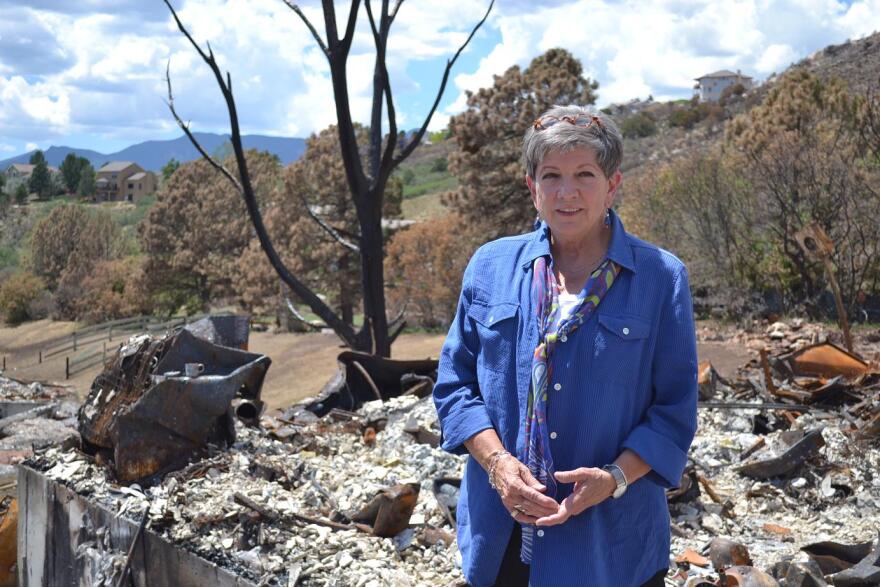Colorado has found itself in the unwelcome national spotlight this summer. Even before the deadly movie theater shootings in Aurora, the state was in the midst of its most destructive and expensive wildfire season in history.
Blazes from Colorado Springs to Estes Park to Larimer County have destroyed more than 630 homes and killed six people this year. Property damages are approaching a half-billion dollars. And many of the wildfire’s victims continue to live their lives in limbo.
Assessing the Damages
A bulldozer scoops up ash and debris in the Mountain Shadows neighborhood in Colorado Springs. When the Waldo Canyon Fire roared over the hill behind it in June, more than 350 houses were destroyed here, reducing this affluent neighborhood at the foot of the mountains to rubble.
“We’re walking on the disintegrated driveway right now,” says Cj Moore as she steps over cracked glass and stone that exploded in the fire’s inferno.
Today only a few blackened trees sway eerily in the wind where her home used to stand on Mirror Lake Court.
“That’s my freezer curled up over there, looks like it’s just curled up,” she says. “Under here is a furnace, completely melted.”

Moore and her late husband built this home on a subdivided ranch in 1985 when he retired from Fort Carson. The Waldo Canyon Fire also destroyed another home nearby she inherited from her father in law.
Moore, a longtime public affairs specialist with Kaiser Permanente, plans to rebuild both, but some things she’ll never be able to replace.
“One of the things I thought about the other day was the flag that was over my late husband’s casket,” Moore says. “I can’t replace that, I mean I can get another flag, but it wouldn’t have served the same purpose, and then tears well up.”
Moore’s insurance company is already replacing what’s replaceable. Friends have given her dish towels and silverware. She’s getting used to accepting charity.
“Most of us are the givers, we’re big supporters of United Way, we’re big supporters of different charities,” Moore says. “It’s been real hard to accept charity.”
Tourism Impacted
Local non-profits have stepped up, and many businesses are offering discounts for victims. All the replacing and rebuilding could create a mini-stimulus to local economies. But that might be tempered by the expected fallout the wildfires are having on Colorado’s multi-billion dollar a year tourism industry.
Two hours north of Colorado Springs, along Highway 287 north of Fort Collins is Rocky Mountain Adventures, a rafting and guiding company.
During the peak season in June, Owner Ryan Barwick had to suspend rafting trips on the nearby Cache Le Poudre River when the High Park Fire blackened more than 135 square miles and destroyed 259 homes.
“A lot of us do live paycheck to paycheck and when you’re shut down for three weeks, you’re a small business we don’t have that cushion to fall back on,” Barwick says.
%22A%20lot%20of%20us%20do%20live%20paycheck%20to%20paycheck.%22
Even before the fire it was hard to sell whitewater trips during a drought. It’s even harder now when the river is a trickle of black sediment running off the canyons above. Barwick has joined with other businesses in the area to offer package deals and discounts in hopes of luring back customers.
“We’ve had rock slides we’ve had mudslides, we’ve had black water, I mean you name it we’ve encountered it this year,” Barwick says. “It’s pretty much every head wind that you fear at the beginning of each season compiled all into one season.”
A Long Recovery
On a recent evening in downtown Fort Collins, people who lost their homes in the High Park Fire met with victims of the 2010 Four Mile Canyon Fire near Boulder.
“A show of hands, how many of you in this room are feeling a sense of extreme hopelessness,” asked one speaker whose house was destroyed in that 2010 fire, which until this year had been the state’s most destructive. The man went on to say things will get better, and the two groups swapped stories of wrangling with their insurance companies and other issues.

High Park victim Teresa Brown didn’t have rental insurance and lost almost everything in the blaze; including a horse trailer, car, kayak and a mountain bike along with most of the contents inside her rental house.
“And the problem for me is that I’m not considered low enough income to get aid,” Brown says.
So she’s been hitting every yard sale she can find and the local Salvation Army.
She may have even found a new rental, in the very same mountain canyon where her old house stood.
Moore isn’t afraid to move back.
“I feel like each part of the country really does have its own weather hazard, and you just choose which ones you like and where you love to be,” she says.
Larimer County recently decided to lower building permit fees for some High Park victims. The federal government is also making some loans available to those who lost everything.
Officials in both the High Park and Waldo Canyon areas say it’s too early to tell how many people will rebuild, but they expect some won't.
“A lot of the reason people moved to the mountains was for the scenic view and to be around the trees, and a lot of that’s gone now,” says Larimer County fire recovery manager Gary Darling.



